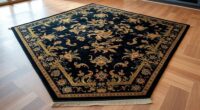Building a diverse portfolio with art, rugs, and wine helps you balance risk, boost potential returns, and add resilience beyond traditional assets. Identify goals, assess your risk tolerance, and research each asset class thoroughly—consider styles, authenticity, and market trends. Diversify to reduce correlation risks, manage storage and insurance carefully, and stay aware of market changes. Continuing your approach will reveal how to optimize this cross-asset strategy for greater stability and growth.
Key Takeaways
- Diversify across art, rugs, and wine to reduce risk and improve portfolio resilience through uncorrelated assets.
- Assess each asset’s liquidity, authenticity, and market trends to optimize buying, selling, and valuation strategies.
- Balance risk and reward by aligning assets with specific goals like growth, preservation, or income.
- Regularly review and rebalance the portfolio considering liquidity needs, market shifts, and tax implications.
- Implement proper storage, insurance, and authentication to preserve physical assets and maximize long-term value.
Understanding the Benefits of Alternative Investments

While traditional investments like stocks and bonds remain popular, alternative investments offer unique benefits that can enhance your portfolio. Digital currencies, for example, provide access to a rapidly growing asset class with high liquidity and potential for significant returns. They diversify your holdings beyond conventional markets, reducing overall risk. Sustainable investing, another key alternative, aligns your portfolio with environmentally and socially responsible companies, supporting ethical growth. These investments often exhibit low correlation with traditional assets, which can help you hedge against market volatility. Incorporating digital currencies and sustainable options allows you to pursue growth while emphasizing values, making your portfolio more resilient and aligned with modern financial trends. Overall, alternative investments broaden your options and strengthen your investment strategy.
Assessing Your Investment Goals and Risk Tolerance

Before establishing an investment portfolio, it’s essential to clearly define your goals and understand your risk tolerance. Knowing whether you aim for long-term growth, preservation, or income helps shape your strategy. Consider liquidity considerations—how easily you can access your assets without penalties—especially with art, rugs, and wine, which may take time to sell. Also, review tax implications; some investments may incur higher taxes or benefits. Use the table below to clarify your priorities:
| Goal | Risk Tolerance | Liquidity Needs |
|---|---|---|
| Capital preservation | Low risk | Require quick access |
| Growth and appreciation | Moderate risk | Flexible, longer term |
| Income generation | Higher risk | Less urgent access |
Assessing these factors ensures your portfolio matches your personal circumstances. Additionally, understanding family photoshoot fails can remind you that unexpected challenges may arise, so having a diversified portfolio can help mitigate unforeseen risks.
Researching the Art Market: Styles, Artists, and Valuations
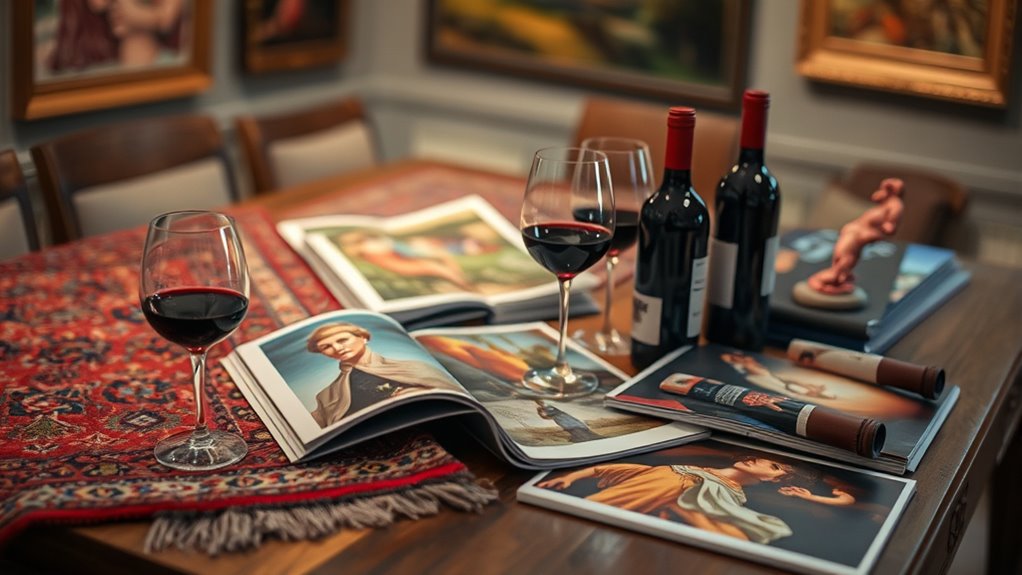
To effectively invest in art, you need to understand the market’s landscape, including popular styles, key artists, and current valuations. Researching the art market involves studying its investment history and market trends, which reveal how certain styles and artists perform over time. Look into past sales data and auction results to identify patterns and evaluate an artwork’s potential appreciation. Stay informed about shifts in collector preferences and emerging movements, as these influence valuations. Knowing the investment history helps you recognize which artists and styles have maintained or increased value. Additionally, understanding market fluctuations can help you anticipate future trends and make better investment decisions. By understanding these dynamics, you can make informed decisions, avoiding fads and focusing on pieces with real growth potential. This research forms the foundation for building a diversified and resilient art portfolio.

Understanding the different types and styles of rugs helps you identify valuable pieces. Authenticity affects a rug’s true worth, so knowing how to spot genuine craftsmanship is essential. By mastering valuation, you can make smarter investment choices in this diverse and intricate market. Additionally, recognizing vintage decor elements can significantly influence a rug’s desirability and overall value.
Rug Types and Styles
Rug types and styles vary widely, each offering distinct characteristics that can influence their authenticity and value. Tapestry patterns often feature intricate, woven designs that highlight craftsmanship, making them ideal for decorative purposes. Persian designs, renowned for their rich history, typically showcase detailed motifs and vibrant colors, reflecting regional traditions. Other styles include tribal rugs with bold geometric patterns and modern, minimalist pieces emphasizing simplicity and contemporary aesthetics. Understanding these differences helps you identify a rug’s origin and stylistic intent. Recognizing the artistic craftsmanship involved in each style can further enhance your appreciation and investment potential. Whether you prefer the elaborate elegance of Persian designs or the textured appeal of tapestry patterns, each style adds unique value to your collection. Recognizing these variations allows you to choose pieces that align with your aesthetic preferences and investment goals.
Authenticity and Valuation
Authenticity substantially influences a rug’s value, and discerning genuine pieces from imitations is essential for collectors and investors alike. Provenance verification helps confirm a rug’s history, ensuring it’s authentic and adds confidence to its worth. Market transparency allows you to evaluate prices accurately and avoid overpaying. Visualize these aspects with this imagery:
| Rug Type | Authenticity Check | Price Range |
|---|---|---|
| Persian Rug | Verified provenance, expert appraisal | $5,000–$50,000 |
| Anatolian Rug | Clear documentation, stylistic analysis | $2,000–$15,000 |
| Chinese Rug | Provenance records, fiber quality | $3,000–$20,000 |
Additionally, understanding the types of rugs and their specific characteristics can aid in making informed investment decisions.
Exploring the Wine Investment Landscape: Regions and Storage
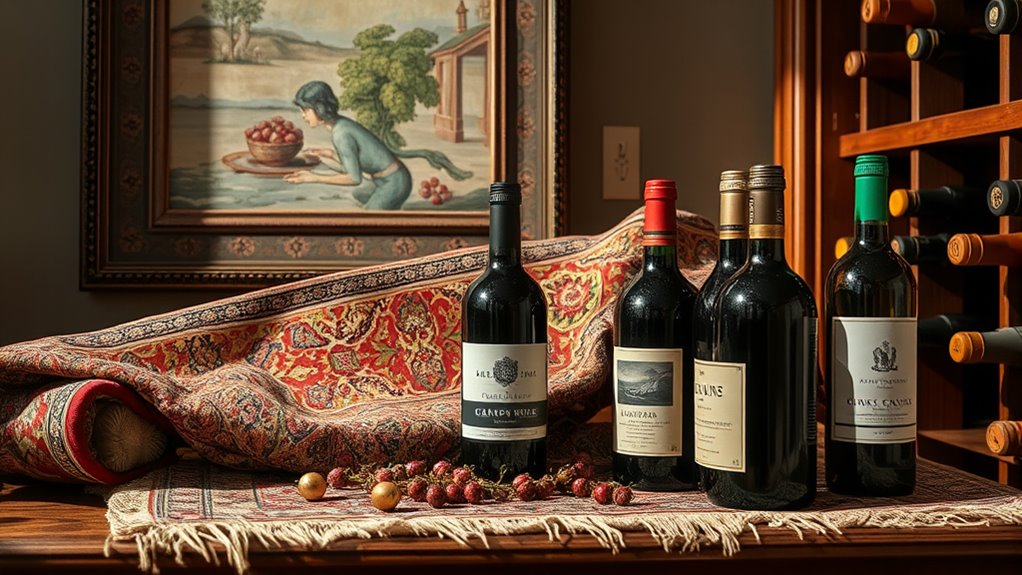
Exploring the wine investment landscape involves examining key regions known for producing valuable and collectible bottles, such as Bordeaux, Burgundy, Napa Valley, and Champagne. Each region offers unique characteristics and aging potential, influencing a wine’s value and desirability. Understanding these wine regions helps you identify promising investments and anticipate market trends. Equally important are storage solutions, which preserve quality and maintain value over time. Proper storage, whether in professional wine cellars or specialized facilities, protects bottles from temperature fluctuations, humidity, and light. Investing in the right storage guarantees your wine remains in prime condition, maximizing return potential. Additionally, the growth of specialty and artisanal wines has introduced new opportunities for diversifying a wine investment portfolio. By knowing where to source wines and how to store them properly, you set a solid foundation for a successful wine investment portfolio.
Diversification Strategies for Cross-Asset Portfolios
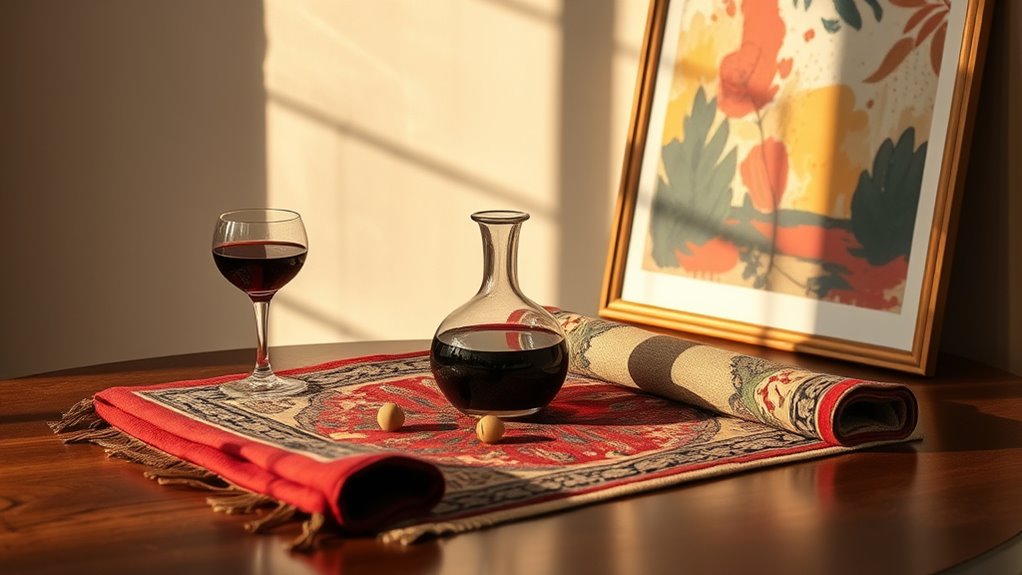
To build a resilient cross-asset portfolio, you need to focus on balancing different asset classes to avoid overconcentration. Consider how risk-adjusted returns can guide your choices, ensuring you get the most value for the level of risk you’re willing to accept. Managing correlations between assets helps you reduce overall volatility and improve your portfolio’s stability. Incorporating performance metrics into your strategy allows for ongoing assessment and adjustment to optimize your diversification efforts.
Asset Class Balance
Achieving the right asset class balance is essential for building a resilient cross-investment portfolio. It helps you navigate liquidity challenges and market volatility, ensuring stability during turbulent times. To do this effectively, consider diversifying across assets with different risk profiles and liquidity characteristics. Incorporating vetted, well-established varieties can also contribute to a more stable and resilient portfolio. Remember, a balanced mix can:
- Reduce exposure to specific market shocks
- Provide liquidity when needed without forcing sale at a loss
- Enhance long-term growth potential through varied asset performance
Maintaining this balance requires regular review, especially as market conditions shift. Adjust your allocations to prevent overconcentration in high-volatility assets or those with limited liquidity. A well-balanced portfolio offers both resilience and flexibility, helping you stay steady through market ups and downs.
Risk-Adjusted Returns
Building a cross-investment portfolio that balances risk and reward requires focusing on risk-adjusted returns. This approach helps you evaluate how well your investments perform relative to the risks involved, especially during market volatility. Diversification across art, rugs, and wine can reduce liquidity challenges, as these assets often have limited liquidity compared to stocks or bonds. By considering risk-adjusted metrics like the Sharpe ratio, you can identify investments that offer better returns for the level of risk they carry. Incorporating assets with high color accuracy and contrast ratios can further optimize your portfolio’s overall efficiency, ensuring you’re not just chasing high returns but managing the risks effectively. This focus allows you to balance risk-adjusted returns helps you build a resilient portfolio that withstands market fluctuations while pursuing growth.
Correlation Management
Managing correlation among your assets is essential for effective diversification in a cross-asset portfolio. Low or negative correlations help reduce overall risk, but you need to actively monitor and adjust these relationships. To do this, consider:
- Timing your market entries and exits carefully to avoid correlated downturns
- Managing liquidity to quickly rebalance assets when correlations shift
- Diversifying across uncorrelated assets like art, rugs, and wine to buffer against market volatility
- Incorporating eye patches into your routine can serve as a metaphor for protective barriers that support asset stability and wellness during turbulent times.
Practical Tips for Buying and Selling Art, Rugs, and Wine

When buying and selling art, rugs, and wine, understanding market trends and authenticating items are essential steps. Digital authentication tools help verify the provenance and authenticity of physical assets, reducing the risk of fakes or misrepresented pieces. Staying informed about market liquidity is equally important; assets like fine art and collectibles can vary in how quickly they sell and at what price. By monitoring current market conditions, you can time your purchases and sales more effectively. Always seek expert opinions and reliable sources for authentication. Keep an eye on digital authentication platforms and market indicators to make well-informed decisions. These practices help protect your investments and maximize returns in this specialized, dynamic market.
Managing Storage, Insurance, and Maintenance of Physical Assets
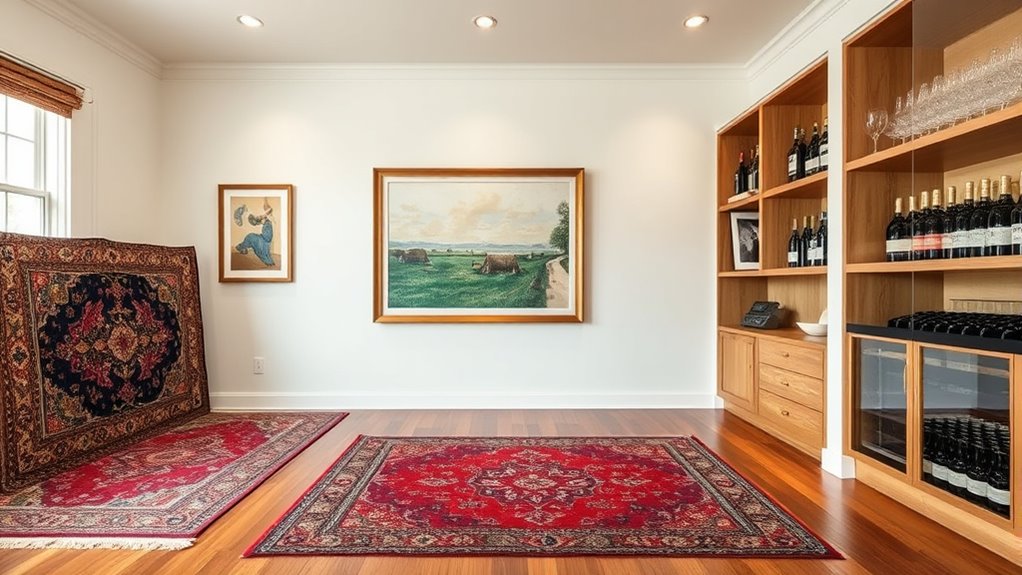
After verifying the authenticity and market value of your assets, taking proper care of their physical condition becomes the next priority. Proper storage, insurance, and maintenance guarantee your investments stay protected and retain value. Consider climate considerations carefully to prevent damage from humidity, temperature fluctuations, or light exposure. Legally, you must comply with local regulations regarding storage and insurance policies to avoid penalties or loss.
Focus on these key points:
- Store assets in climate-controlled environments to preserve quality
- Insure your assets adequately against theft, damage, or loss
- Regularly inspect and maintain assets to prevent deterioration
Monitoring and Rebalancing Your Multi-Asset Portfolio

Regularly monitoring your multi-asset portfolio is essential to guarantee it aligns with your financial goals and risk tolerance. Keep an eye on market liquidity, as some assets like art or wine can be less liquid, affecting your ability to sell quickly without losses. Rebalancing helps maintain your desired asset allocation, especially when market movements cause deviations. Be aware of tax implications; selling assets for rebalancing may trigger capital gains taxes, impacting your returns. Adjust your portfolio thoughtfully, considering both market conditions and tax efficiency. Regular reviews allow you to respond promptly to changes, ensuring your portfolio stays aligned with your objectives. By staying proactive, you optimize the balance between diverse investments and manage risks effectively.
Frequently Asked Questions
How Do I Authenticate and Verify the Provenance of Art and Rugs?
To authenticate and verify the provenance of art and rugs, you should start with thorough provenance research, tracing the item’s history and ownership. Use expert authenticity verification services, such as appraisers or specialized laboratories, to confirm its legitimacy. Check for certificates of authenticity and compare the piece with verified records. This process helps guarantee your investment is genuine, reducing risks and increasing confidence in your cross-investment portfolio.
What Are the Tax Implications of Investing in Art, Rugs, and Wine?
When investing in art, rugs, and wine, you need to take into account tax implications like tax reporting and capital gains. You might owe taxes on any profits when you sell, and rules vary by country. Keep detailed records of your purchases and sales, as these are essential for accurate tax reporting. Consulting a tax professional ensures you comply with regulations and optimize your investment returns.
How Can I Access Expert Valuation Services for These Alternative Assets?
Think of expert valuation services as your treasure map, guiding you through the hidden world of alternative assets. You can access these by consulting specialized appraisers or auction houses for art and rugs, and wine experts or connoisseurs for fine bottles. Look for professionals offering provenance verification to confirm authenticity. Online platforms and industry associations also connect you with trusted valuation services, ensuring your investments are accurately appraised and well-protected.
What Are the Best Practices for Estate Planning With Physical Collectibles?
When estate planning with physical collectibles, you should consider insurance coverage to protect your assets from damage or loss. Develop clear inheritance strategies, including detailed documentation and appraisals, to make certain smooth transfers to heirs. Consult with estate planning professionals to incorporate these collectibles into your overall estate plan, addressing tax implications and legal requirements. Proper planning helps preserve your collection’s value and ensures your wishes are honored for future generations.
How Do Fluctuations in Global Markets Affect Art, Rug, and Wine Investments?
Did you know that during recent global market fluctuations, art and wine investments have shown resilience, often acting as hedges? Market volatility and currency risks can impact these assets, causing value swings and affecting returns. When markets wobble, your art, rugs, and wine may either hold steady or become more attractive as alternative investments. Staying informed helps you navigate these risks and protect your valuable collectibles from unpredictable global changes.
Conclusion
Building a cross-investment portfolio is like tending a vibrant garden—you need to nurture each asset type carefully. By understanding art, rugs, and wine, you create a diverse landscape that can flourish through smart research and strategic management. Keep an eye on your investments, rebalance when needed, and enjoy the rich tapestry you’ve cultivated. With patience and attention, your portfolio will bloom into a rewarding masterpiece.

